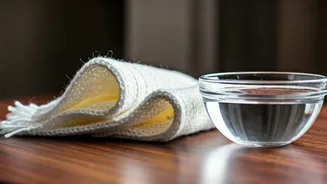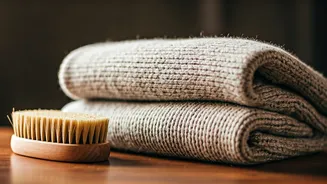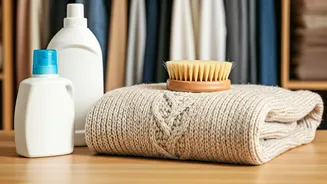Gentle Wash Only
The first 'do' is to always opt for a gentle wash cycle. Wool fibres are delicate and susceptible to damage from harsh machine agitation. Whether you choose
to hand wash or use a washing machine, the key is to be gentle. When hand washing, use lukewarm water and a mild detergent specifically designed for wool. Submerge the garment, gently swish it around, and avoid any harsh rubbing or twisting. If using a machine, always select the delicate or wool cycle, using cold water to prevent shrinking or damage. Place your woollens in a mesh laundry bag to offer extra protection against friction.
Detergent Dilemma
Choosing the right detergent is an essential part of washing woollens. Avoid regular detergents, as they often contain harsh chemicals and enzymes that can strip away the natural oils from the wool fibres. Instead, use a detergent specifically designed for wool. These detergents are pH-neutral and contain conditioning agents that help maintain the softness and shape of your garments. Alternatively, consider using a gentle liquid soap or even a baby shampoo, which can be effective and less harsh. Always measure the detergent carefully and avoid overdoing it, as excess detergent can leave residue on your clothes, making them stiff.
Water Temperature Matters
Controlling the water temperature is crucial when washing wool. Cold water is your best friend when it comes to preserving the integrity of wool. Hot water can cause the wool fibres to shrink and felt, ruining the garment's shape and texture. Whether you are hand washing or using a machine, always use cold water. During rinsing, ensure all the detergent is removed by rinsing thoroughly in cold water until the water runs clear. Never use hot water during any part of the washing process, as it can cause irreversible damage. Remember, cold water is key to keeping your woollens looking their best and maintaining their original fit.
No Wringing or Twisting
When dealing with wet wool, the 'don't' of wringing or twisting is a crucial rule. These actions can distort the shape of the garment and damage the delicate fibres, leading to stretching and loss of shape. Instead of wringing, gently squeeze out excess water, supporting the garment's weight. Avoid twisting the fabric, as this puts undue stress on the fibres. You can also press the item between clean, absorbent towels to remove moisture. This technique helps to absorb water without causing any distortion. Remember, patience and gentle handling are vital when drying wool, as they prevent damage and ensure your woollens maintain their original appearance.
Air Dry Properly
The method of drying woollens is extremely important. Never put wool clothes in a tumble dryer, as the heat will shrink and damage them. Instead, always air dry your wool garments. Lay the item flat on a clean, dry surface or a drying rack, ensuring it's in its original shape. Avoid direct sunlight or heat, as this can cause fading or damage. Rotate the garment occasionally to ensure even drying. Alternatively, you can hang the garment on a padded hanger, away from direct sunlight. Ensuring proper airflow around the garment will speed up drying and prevent musty odours. It's best to dry woollens in a well-ventilated area, and never rush the drying process.
Fold, Don’t Hang
When it comes to storing your woollens, folding is the ideal practice. Hanging woollen garments, such as sweaters, can stretch them out of shape, especially over time. Instead, fold your wool items neatly and store them in a drawer or on a shelf. Place heavier items at the bottom and lighter items on top. This method helps to maintain the garment's shape and prevent unsightly shoulder bumps. If you must hang a wool item, like a coat, use a padded hanger to reduce the risk of stretching. Proper storage helps to preserve the shape and extend the life of your woollen garments, ensuring they look great when you wear them next.
Protect from Pests
Protecting woollens from moths and other pests is a key aspect of long-term storage. Moths are naturally attracted to wool, so it's important to take preventative measures. Before storing, ensure your woollens are clean, as moths are drawn to stains and odours. Use cedarwood blocks or lavender sachets in your storage areas. Cedarwood repels moths, while lavender acts as a deterrent. Store your woollens in airtight containers or bags to prevent pest infestation. Regularly inspect your stored woollens for any signs of moth activity, such as small holes or webbing. Proactive pest protection is critical to safeguarding your woollen collection and maintaining its beauty.
Clean Before Storing
Always clean your woollens before putting them away for storage. Even if a garment appears clean, it may still have invisible dirt, dust, and body oils that can attract pests and cause discolouration. Wash or dry clean your woollens before storing them away. Make sure the garment is completely dry before storing it, as any moisture can cause mildew and damage the fibres. Proper cleaning ensures that your woollens are in the best condition when you take them out of storage. This simple step can make a big difference in maintaining the longevity and appearance of your woollen clothes. Avoid storing dirty woollens to prevent pest infestation and maintain freshness.
Avoid Direct Sunlight
Protecting your woollens from direct sunlight is crucial to prevent colour fading and damage. When storing woollens, keep them in a cool, dark, and dry place. Direct sunlight can cause colours to fade and the fibres to weaken over time. Avoid storing your wool items in areas exposed to sunlight, like windowsills or poorly covered shelves. If you must store woollens in a place with some light exposure, consider using opaque storage containers or wrapping the items in acid-free tissue paper or cotton sheets. This helps to create a protective barrier. Proper storage away from direct sunlight ensures the colours stay vibrant and the fibres stay strong, preserving your woollens' original look.











